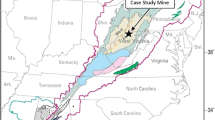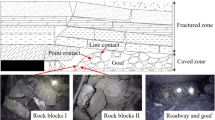Abstract
This paper proposes a new method to estimate the percentage of load carried by the gob in underground coal mines using a new parameter that introduces the site-specific overburden geology. The new parameter was defined as the total strong layer thickness (tstr) that represents the strength and stiffness of the overburden with a single value. Twelve field measurement case studies from 11 different U.S. longwall mines with different overburden geologies were used to develop the new methodology. 2D numerical models of these case studies (and additional parametric runs with different panel widths) were verified against field measurements such as surface subsidence and stress. Statistical analyses using the model results were conducted for a loading model with the new tstr parameter as one of the variables. The new methodology was found to have a coefficient of determination (R2) of 85% when compared to the field measurements and the parametric models. The method was then tested for practical implementation for pillar design. The percentages of load carried by the gob as estimated by the new method were implemented into the LaModel program, that is commonly used in the coal industry. The results obtained from LaModel were compared to the available field stress measurements, and the new method implemented into LaModel was found to give successful results.


















Similar content being viewed by others
Data Availability
All the published data can be provided upon the request. However, mine names and the raw field measurement data cannot be provided due to the confidentiality agreement between the authors and the industry partners.
Code Availability
N/A
References
Mark C, Agioutantis Z (2019) Analysis of coal pillar stability (ACPS): a new generation of pillar design software. Int J Min Sci Technol 29(1):87–91
Mark C (1992) Analysis of longwall pillar stability (ALPS): an update. Proc Work Coal Pillar Mech Design 238–249. U.S. Bureau of Mines Information Circular 9315. U.S. Department of the Interior, Washington, DC
Mark C, Chase F (1997) Analysis of retreat mining pillar stability (ARMPS). Proceedings of New Technology for Ground Control in Retreat Mining IC 9446. U.S. Dept Health Human Serv, Centers Dis Control Prev (NIOSH), Pittsburgh, pp 17–34
Mark C, Chase F, Pappas D (2007) Analysis of multiple seam stability. Proc 26th Int Conf Ground Control Min, Morgantown, pp 5–18
Colwell M, Frith R, Mark C (1999) Analysis of longwall tailgate serviceability (ALTS): a chain pillar design methodology for Australian conditions. Proc 2nd Int Work Coal Pillar Mech Des. NIOSH: IC 9448, pp 33–48
Bieniawski Z (1984) Rock mechanics design in mining and tunneling. Balkema
Mark C, Bieniawski Z (1986) An empirical method for the design of chain pillars for longwall mining. Proc 27th U.S. Symp Rock Mech, Tuscaloosa, pp 415–422
Mark C (2010) ARMPS 2010: pillar design for deep cover retreat mining. Proceedings of the Third International Workshop on Coal Pillar Mechanics and Design. Natl Inst Occup Saf Health (NIOSH), Pittsburgh, pp 104–120
Luo Y, Qiu B (2012) CISPM-MS: a tool to predict surface subsidence and to study interactions associated with multi–seam mining operations. Proc 31st Int Conf Ground Control Min, Morgantown, pp 56–62
Karmis M, Jarosz A, Agioutantis Z (1989) Predicting subsidence with a computer. Coal 26(12):54–61
Agioutantis Z, Karmis M (2017) Quick reference guide and working examples, SDPS for Windows v6.2J
Tulu I, Heasley K (2012) Investigating abutment load. Proc 31st Int Conf Ground Control Min, Morgantown, pp 28–37
Hill D, Stone R, Suchowerska A, Trueman R (2015) Pillar abutment loading—new concepts for coal mining industry. Proc 15th Coal Operators' Conf. University of Wollongong: The Australasian Institute of Mining and Metallurgy and Mine Managers Association of Australia, pp 204–211
Tuncay D, Tulu I, Klemetti T (2020) Analysis of ARMPS2010 database with LaModel and an updated abutment angle equation. Int J Min Sci Technol 30(1):111–118
Itasca Consulting Group (2018) Flac3D user’s guide, version 6.00. Itasca Consulting Group, Minnesota
Tuncay D, Tulu I, Klemetti T (2020) Re-analysis of abutment angle method for moderate and deep cover retreat room and pillar mines and investigation of loading mechanics using finite volume modeling. Rock Mech Rock Eng 54:3447–3468
Esterhuizen, G., Mark, C., & Murphy, M. (2010). Numerical model calibration for simulating coal pillars, gob and overburden response. Proc 29th Int Conf Ground Control Min. Morgantown, pp 1–12
Tulu I, Esterhuizen G, Mohamed K, Klemetti T (2017) Verification of a calibrated longwall model with field measurements. Proc 51st US Rock Mech/Geomech Symp. San Francisco
Pappas D, Mark C (1993) Behavior of simulated gob material. RI 9458. U.S. Department of the Interior, Bureau of Mines, Washington, DC
Salamon M (1990) Mechanism of caving in longwall coal mining. Proceedings of the 21st U.S. Rock Mechanics Symposium. Denver, pp 161–168
Tulu I, Esterhuizen G, Gearhart D, Klemetti T, Mohamed K, Su D (2018) Analysis of global and local stress changes in a longwall gateroad. Int J Min Sci Technol 28(1):127–135
Li W, Bai J, Peng S, Wang X, Xu Y (2015) Numerical modeling for yield pillar design: a case study. Rock Mech Rock Eng 48:305–318
Zhang G, He F, Jia H, Lai Y (2017) Analysis of gateroad stability in relation to yield pillar size: a case study. Rock Mech Rock Eng 50:1264–1278
Feng G, Wang P, Chung Y (2019) Stability of gate roads next to an irregular yield pillar: a case study. Rock Mech Rock Eng 52:2741–2760
Su D (1991)\ Finite element modeling of subsidence induced by underground coal mining: the influence of material nonlinearity and shearing along existing planes of weakness. Proc 10th Int Conf Ground Control Min. Morgantown, pp 287–300
Zhao H, Tulu I (2020) Verification of Modeling Methodology for Investigating Stress Redistribution at Deep Western U.S. Longwall Coal Mines. Proc 54th US Rock Mech/Geomech Symp
Luo Y (1989) An integrated computer model for predicting surface subsidence due to underground coal mining: "CISPM". Ph.D. Dissertation. West Virginia University
Klemetti T, Van Dyke M, Tulu I, Tuncay D, Wickline J, Compton C (2019) Longwall gateroad yield pillar response and model verification—a case study. 53rd US Rock Mech/Geomech Symp New York
Klemetti T, Van Dyke M, Tulu I, Tuncay D (2020) A case study of the stability of a non typical bleeder entry system at a U.S. longwall mine. Int J Min Sci Technol 30(1):25–31
Van Dyke M, Klemetti T, Tulu I, Tuncay D (2021) Moderate cover bleeder entry and standing support performance in a longwall mine: a case study. Mining, Metallurgy & Exploration 38:885–896
Campoli A, Barton T, Van Dyke F, Gauna M (1993) Gob and gate road reaction to longwall mining in bump-prone strata. Report Investig 9445 (Bureau of Mines)
Salamon M, Oravecz K, Hardman D (1972) Rock mechanics problems associated with longwall trials in South Africa. Proc 5th Int Strata Control Conf, London, pp 1–21
Galvin J (1981) The mining of South African thick coal seams: rock mechanics and mining considerations. Ph.D. Dissertation, University of the Witwatersrand
Salamon M (1962) The influence of strata movement and control on mining development and design. Ph.D. Dissertation, University of Durham
Salamon M (1991) Deformation of stratified rock masses: a laminated model. Journal of South African Institute of Mining and Metallurgy 91(1):9–25
Heasley KA (1998) Numerical modeling of coal mines with a laminated displacement-discontinuity code. Ph.D. Dissertation. Colorado School of Mines
Heasley K, Agioutantis Z (2001) LAMODEL—a boundary element program for coal mine design. Proc 10th Int Conf Comput Methods Adv Geomech 1678–1682. Taylor & Francis, Oxford
Heasley K, Agioutantis Z, Wang Q (2003) Automatic grid generation allows faster analysis of coal mines. Trans Soc Min Metall Explor Inc., Cincinnati, pp 75–80
Hardy R, Heasley K (2006) Enhancements of the LaModel stress analysis program. Society of Mining Engineers Annual Meeting, St. Louis
Sears M, Heasley K (2009) An application of energy release rate. Proc 28th Int Conf Ground Control Min, Morgantown, pp 10–17
Heasley KA, Sears MM, Tulu IB, Calderon-Arteaga CH, Jimison II LW (2010) Calibrating the LaModel program for deep cover pillar retreat coal mining. Proc 3rd Int Work Coal Pillar Mech Design. Morgantown, pp 47–57
Sears M (2013) Calibrating the LaModel program for shallow cover multiple-seam mines. Ph.D. Dissertation. Morgantown, West Virginia University
Peng S, Chiang H (1984) Longwall mining. John Wiley & Sons, New York
Acknowledgements
This study was sponsored by the Alpha Foundation for the Improvement of Mine Safety and Health, Inc.
Funding
This study was funded by the Alpha Foundation for the Improvement of Mine Safety and Health, Inc. (Alpha Foundation). Grant No: AFC719-15.
Author information
Authors and Affiliations
Contributions
All authors contributed to the study conception and design. Material preparation, data collection, and analysis were performed by Deniz Tuncay, Ihsan Berk Tulu, and Haochen Zhao. The first draft of the manuscript was written collaboratively by all authors. All authors read and approved the final manuscript.
Corresponding author
Ethics declarations
Conflict of Interest
The authors declare no competing interests.
Disclaimer
This study was sponsored by the Alpha Foundation for the Improvement of Mine Safety and Health, Inc. The views, opinions, and recommendations expressed herein are solely those of the authors and do not imply any endorsement by the Alpha Foundation, its directors, and staff.
Additional information
Publisher's Note
Springer Nature remains neutral with regard to jurisdictional claims in published maps and institutional affiliations.
Rights and permissions
About this article
Cite this article
Tuncay, D., Tulu, I.B. & Zhao, H. Geology-Oriented Load Estimation Approach for Underground Coal Mines. Mining, Metallurgy & Exploration 39, 1899–1915 (2022). https://doi.org/10.1007/s42461-022-00658-1
Received:
Accepted:
Published:
Issue Date:
DOI: https://doi.org/10.1007/s42461-022-00658-1




